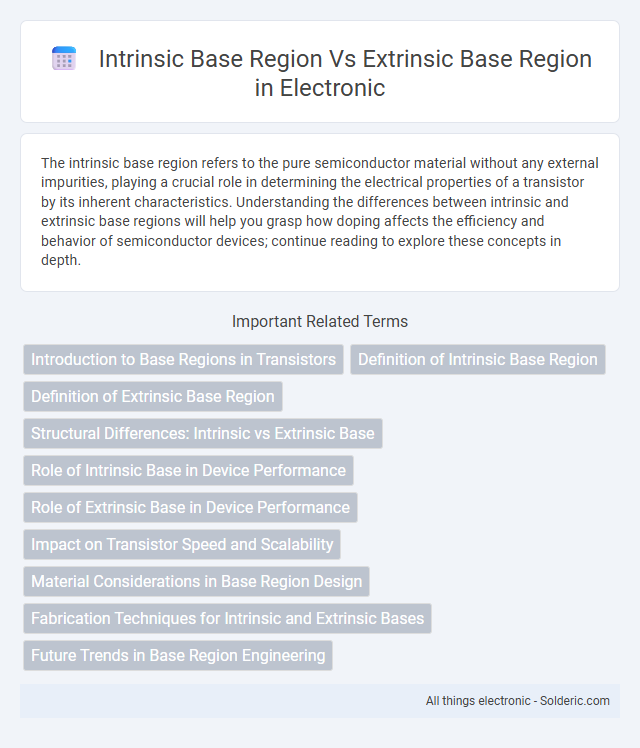The intrinsic base region refers to the pure semiconductor material without any external impurities, playing a crucial role in determining the electrical properties of a transistor by its inherent characteristics. Understanding the differences between intrinsic and extrinsic base regions will help you grasp how doping affects the efficiency and behavior of semiconductor devices; continue reading to explore these concepts in depth.
Comparison Table
| Feature | Intrinsic Base Region | Extrinsic Base Region |
|---|---|---|
| Definition | Base region formed during the transistor crystal growth. | Base region created by external doping after crystal growth. |
| Doping Control | Controlled intrinsically during the manufacturing process. | Doping level adjusted externally via diffusion or ion implantation. |
| Purity | Higher purity with fewer defects. | May introduce defects due to post-growth processing. |
| Process Complexity | Less complex, integrated in the initial growth phase. | More complex, requires additional doping steps. |
| Application | Common in bipolar junction transistors with uniform base doping. | Used for customized transistor characteristics and performance tuning. |
| Cost | Lower cost due to fewer processing steps. | Higher cost owing to extra doping operations. |
Introduction to Base Regions in Transistors
The intrinsic base region in transistors refers to the undoped or lightly doped semiconductor material situated between the emitter and collector, essential for controlling current flow. The extrinsic base region surrounds the intrinsic base and includes heavily doped areas that provide low-resistance contacts for external circuit connections. Understanding the distinction between intrinsic and extrinsic base regions is crucial for optimizing transistor performance and ensuring efficient charge carrier injection and collection.
Definition of Intrinsic Base Region
The intrinsic base region refers to the undoped or lightly doped area within a semiconductor device, typically found in bipolar junction transistors (BJTs), where the base material is pure or nearly pure semiconductor without significant impurity atoms introduced. It plays a crucial role in controlling the flow of charge carriers between the emitter and collector, ensuring efficient transistor operation. In contrast, the extrinsic base region is heavily doped to provide low resistance paths for electrical connections, enhancing the device's overall conductivity.
Definition of Extrinsic Base Region
The extrinsic base region refers to the portion of a bipolar junction transistor (BJT) base that includes externally introduced dopants to modify the intrinsic semiconductor properties. This region is strategically doped to control current flow and improve transistor performance by influencing carrier injection and recombination rates. Understanding the distinction between the intrinsic and extrinsic base regions helps optimize your transistor's electrical characteristics and overall device efficiency.
Structural Differences: Intrinsic vs Extrinsic Base
The intrinsic base region is formed by the semiconductor material itself, typically silicon or germanium, exhibiting uniform doping and crystal structure, whereas the extrinsic base region is engineered by introducing specific impurities to control electrical properties. Structural differences lie in the intrinsic base's natural lattice formation compared to the extrinsic base's modified doping profile, which enhances carrier injection and transistor performance. Understanding these distinctions helps optimize Your device's efficiency in bipolar junction transistors (BJTs) by tailoring the base region precisely.
Role of Intrinsic Base in Device Performance
The intrinsic base region plays a critical role in device performance by directly controlling charge carrier recombination and transport efficiency, which enhances current gain and switching speeds in bipolar junction transistors. Unlike the extrinsic base, which mainly provides contact access, the intrinsic base determines the transistor's amplification capabilities through its precise doping profile and thickness. Optimizing the intrinsic base region enables improved transistor performance, reduced power consumption, and greater overall device reliability for your electronic circuits.
Role of Extrinsic Base in Device Performance
The extrinsic base region in bipolar junction transistors (BJTs) significantly enhances device performance by reducing base resistance and improving current gain. It provides a low-resistance path for carrier injection, facilitating efficient charge transport and minimizing voltage drop across the base. This region's optimized doping and geometric design directly impact switching speed and frequency response, critical for high-speed and high-frequency applications.
Impact on Transistor Speed and Scalability
The intrinsic base region significantly impacts transistor speed by reducing carrier transit time, enhancing high-frequency performance and switching speed. In contrast, the extrinsic base region mainly affects scalability by increasing parasitic resistance and capacitance, which slow down the transistor and limit integration density. Optimizing the intrinsic base for minimal thickness and the extrinsic base for reduced contact resistance is crucial for advancing transistor speed and scalability in modern semiconductor devices.
Material Considerations in Base Region Design
The intrinsic base region in bipolar junction transistors typically utilizes high-purity silicon or silicon-germanium alloys to achieve optimal charge carrier mobility and reduce recombination rates. The extrinsic base region often incorporates heavily doped materials, such as silicon doped with boron, to enhance conductivity and facilitate efficient ohmic contact formation. Material selection in the base region balances the need for low resistivity in the extrinsic base with minimal defect density in the intrinsic base to ensure superior transistor performance and reliability.
Fabrication Techniques for Intrinsic and Extrinsic Bases
Fabrication techniques for intrinsic base regions involve epitaxial growth to create a very pure, lightly doped silicon layer, ensuring minimal impurities and high carrier mobility essential for transistor performance. In contrast, extrinsic base regions are formed by heavy doping through ion implantation or diffusion processes to introduce a high concentration of acceptor atoms, enhancing conductivity and reducing base resistance. Optimizing the balance between intrinsic purity and extrinsic doping profiles is critical for achieving the desired electrical characteristics in bipolar junction transistors (BJTs).
Future Trends in Base Region Engineering
Future trends in intrinsic base region engineering emphasize the incorporation of novel semiconductor materials such as silicon carbide and gallium nitride to enhance carrier mobility and thermal stability. In contrast, extrinsic base region advancements focus on nanostructuring techniques and atomic-level doping precision to minimize base resistance and optimize transistor switching speeds. Both approaches aim to significantly improve overall transistor performance and energy efficiency in next-generation electronic devices.
Intrinsic base region vs Extrinsic base region Infographic

 solderic.com
solderic.com